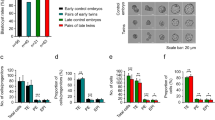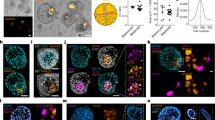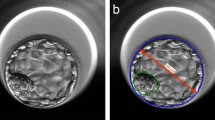Abstract
THE mouse blastocyst consists of a group of cells, the inner cell mass (ICM), attached to a small area of the inside surface of a sphere of trophectoderm cells. The trophecto-derm gives rise to the extraembryonic regions of the conceptus while the ICM forms the embryo proper1. At implantation trophoblast cells invade the uterine epithelium. Those overlying the ICM proliferate to form the ectoplacental cone and the extraembryonic ectoderm and the remainder undergo transformation into giant cells2. The cells of the inner cell mass divide further, and, together with the extraembryonic ectoderm, give rise to a column of cells, the egg cylinder, that extends into the blastocyst cavity (blastocoele). Lactic dehydrogenase A subunits (4A, LDH-5) appear at this time3, and may be synthesised first in tissue deriving from the ICM4. Subsequently LDH-4 (3A1B) and LDH-3 (2A2B) appear as the contribution of B subunits to the pattern increases. If implantation is prevented, further development of the blastocyst is arrested5 and LDH-5 fails to appear3. Implantation therefore seems to act as a trigger, not only for trophoblast proliferation, but also, directly or indirectly, for further development of ICM. In the work reported here we have varied the conditions of culture of isolated blastocysts and have elicited alternative forms of development that mimic those observed in vivo when implantation occurs or is prevented. We have shown further that the triggering of ICM development in vitro may represent the release from an inhibitory effect of trophectoderm.
This is a preview of subscription content, access via your institution
Access options
Subscribe to this journal
Receive 51 print issues and online access
$199.00 per year
only $3.90 per issue
Buy this article
- Purchase on SpringerLink
- Instant access to full article PDF
Prices may be subject to local taxes which are calculated during checkout
Similar content being viewed by others
References
Gardner, R. L., and Papaioannou, V. E., in The Early Development of Mammals (edit. by Balls, M.,and Wild, A. E. ), 107–132 (Cambridge University Press, 1975).
Gardner, R. L., and Johnson, M. H., J. Embryol. exp. Morph., 28, 279–312 (1972).
Auerbach, S., and Brinster, R. L. Expl Cell Res., 46, 89–92 (1967).
Monk, M., and Ansell, J., J. Embryol. exp. Morph. (in the press).
Mayer, G., in Delayed Implantation, (edit. by Enders, A. C. ) 213, (University of Chicago Press, Chicago, 1963).
Solter, D., and Knowles, B. A. Proc. natn. Acad. Sci. U.S.A., 72, 5099–5102 (1975).
Engel, W., and Petzoldt, U. Humangenetik, 20, 125–131 (1973).
Rights and permissions
About this article
Cite this article
MONK, M., PETZOLDT, U. Control of inner cell mass development in cultured mouse blastocysts. Nature 265, 338–339 (1977). https://doi.org/10.1038/265338a0
Received:
Accepted:
Issue date:
DOI: https://doi.org/10.1038/265338a0
This article is cited by
-
Influence of embryo size on lactate dehydrogenase isozyme expression in giant mouse chimaeras
Anatomy and Embryology (1988)
-
Expression of lactate dehydrogenase isozyme 5 (LDH-5) in cultured mouse blastocysts in the absence of implantation and outgrowth
Biochemical Genetics (1978)



